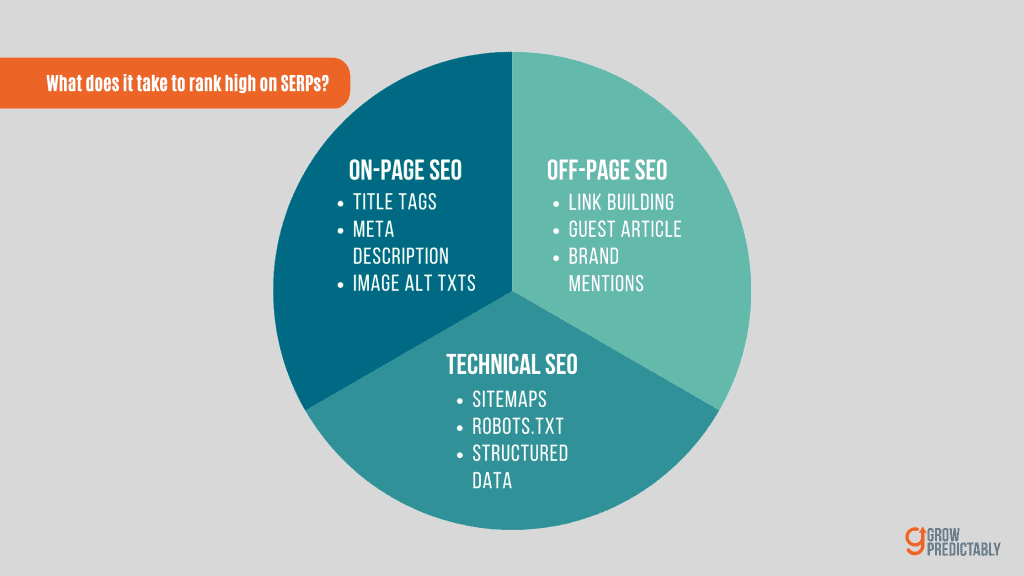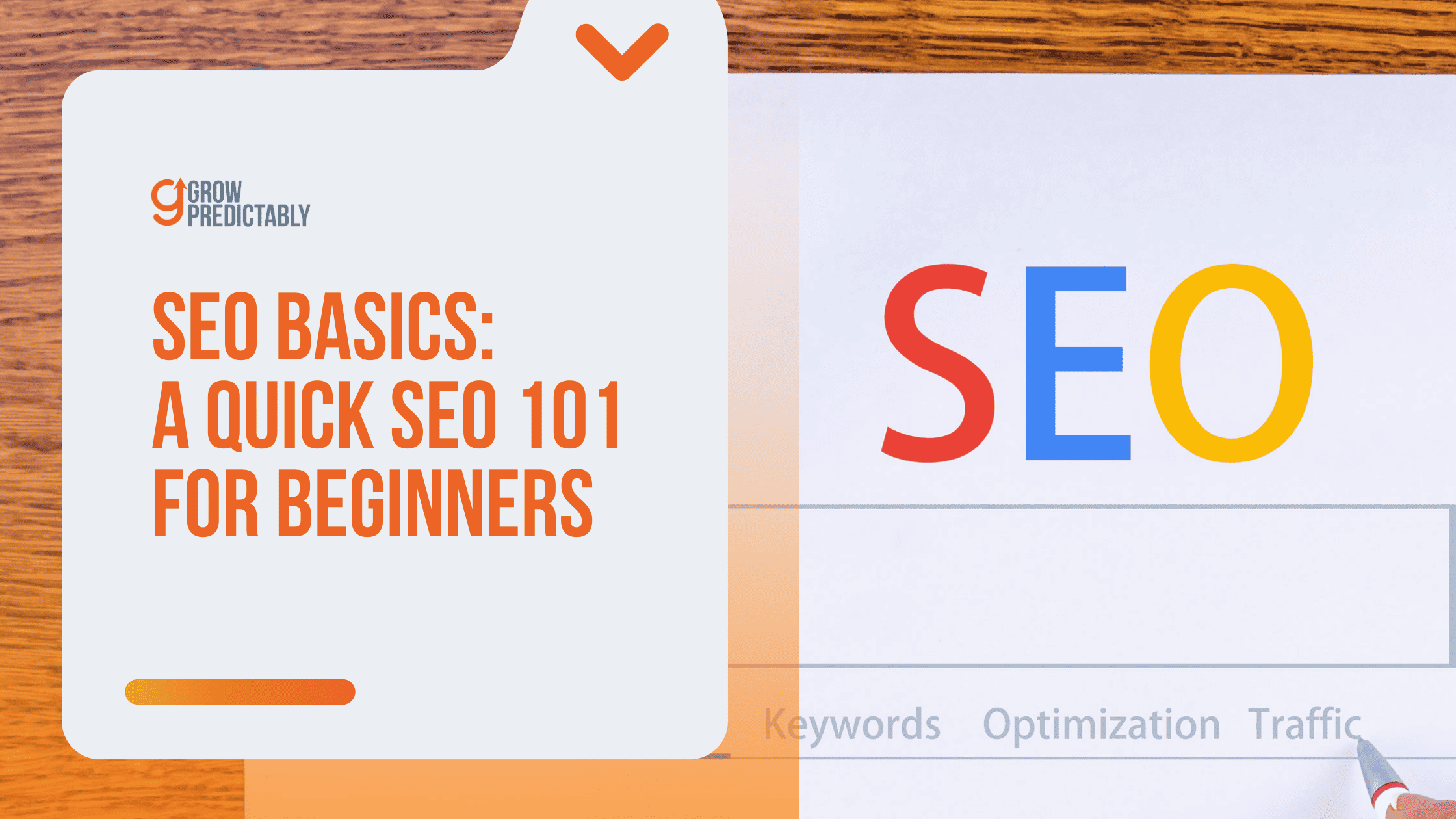SEO Basics: A Quick SEO 101 for Beginners
A 2022 report by Internet Live Stats reveals that Google processes approximately 99,000 searches every second, highlighting the immense demand for information online.
This translates to opportunity for businesses, and SEO is the key to capitalizing on it.
SEO, or search engine optimization, is crucial for conducting business online. It enables your website to rank higher on search engine results pages (SERPs), attracting more visitors and target customers.
But what exactly is Search Engine Optimization (SEO)? How can you implement it? And how does search marketing contribute to employing SEO best practices? This beginner’s guide to SEO 101 will address these questions!
What is SEO?

Search engine optimization (SEO) entails fine-tuning web pages and website components to ensure your content ranks higher in organic search results. This makes it much easier for internet users to discover your content as they search various topics on the web.
SEO requires examining and comprehending how search engines operate while ranking online content, as well as executing strategies that boost the prominence of a web page or website on platforms such as Google.
Why is SEO so important?
Search engine optimization (SEO) serves as a priceless asset for businesses, big and small. It empowers small brands, entrepreneurs, and companies to draw more customers to their websites, elevate brand recognition, and enhance their presence in search engine rankings.
By fine-tuning web pages, SEO propels them to higher positions on search engine results pages (SERPs), increasing their visibility in the digital world.
Its targeted approach sets SEO apart, ensuring you connect with the right audience instead of just anyone.
Moreover, SEO refines the user experience on your website, making it a breeze for customers to find exactly what they seek.
Grasping the fundamentals of SEO is crucial for businesses desiring organic website traffic, especially in this digital age where fierce online competition is the norm.
The 3 Components of SEO

Apart from grasping the fundamental and crucial terms in SEO, it’s equally vital to pinpoint the various facets of regular SEO.
Subsequently, we’ll shed light on the rationale behind using the term ‘regular SEO.’
Outstanding SEO encompasses more than just keywords. In order to execute effective SEO, it’s necessary to focus on three primary areas.
1. On-Page SEO
On-page SEO involves enhancing different webpage content elements to increase their visibility for both users and search engine bots.
This technique is crucial to any SEO strategy, as it aids in boosting a website’s position on SERPs (search engine result pages).
On-page SEO encompasses the optimization of components like titles, headings, content, and meta descriptions. In essence, on-page SEO targets various elements present on your webpage.
2. Off-Page SEO
Off-page SEO can be performed through link-building and other tactics. Basically, it involves methods that enhance a website’s search rankings by boosting the level of inbound links from other sites.
This is achieved through establishing connections with influencers, contributing guest posts to other websites, obtaining reviews for your products or services from customers and various sites, and generating brand mentions.
3. Technical SEO
Technical SEO is all about fine-tuning the technical elements of a website for search engines.
This process encompasses optimizing your website’s architecture and code, enhancing page speed and loading times, making sure search engine crawlers can quickly discover content, rectifying broken links and redirects, and guaranteeing that URLs are SEO-compatible.
7 Different Types of SEO
By now, you’re familiar with the concept of SEO and its crucial role in the current business environment. However, there are three additional kinds of SEO beyond the ones we previously explored in this article.
1. Standard SEO
The conventional form of SEO, often simply referred to as ‘SEO,’ focuses on enhancing websites for greater visibility and improved rankings on SERPs. Local and international SEO, on the other hand, have distinct technical aspects when contrasted with standard SEO.
2. Local SEO
Focusing on geographically-related searches, Local SEO is a unique variation of SEO that aims to optimize a website’s visibility. Basically, Local SEO is a strategy to make your web pages more visible in Google’s local SERPs.
This encompasses searches pertaining to a business’s location or service area, like “restaurants near me” or “dentists in [city].”
Local SEO holds significance for businesses of all sizes, as it enables them to connect with potential local customers who not only require their products and services but are also in close proximity.
3. International SEO
International SEO entails optimizing websites to function effectively across various regions globally. Simply put, International SEO optimizes your pages to rank higher in other countries.
This process involves adapting content, including text, images, videos, and other elements, to suit the local culture and language, ensuring it resonates with the intended audience.
Additionally, international SEO necessitates extra measures such as examining regional SEO patterns, refining URL structures, and implementing hreflang tags.

4. SEO for eCommerce
E-commerce SEO covers the needs of e-commerce websites in optimization. Its primary goal is to optimize websites for search engines like Google, Bing, and Yahoo!, ensuring maximum visibility and an influx of organic search traffic.
Regarding e-commerce sites, SEO essentials such as page titles, meta descriptions, and SEO-friendly URLs are of utmost importance. These basic optimizations lay the foundation for a well-structured website.
Furthermore, concentrating SEO efforts on product and category pages is crucial, as this guarantees they are indexed by Google, making them easily discoverable by customers.
Lastly, an effective e-commerce SEO strategy must incorporate keyword research, which enables the creation of targeted content that resonates with your customer base and appeals to their needs.
5. YouTube SEO
YouTube SEO is about fine-tuning your YouTube videos and channels to rank higher in YouTube search results.
To achieve this, incorporate relevant keywords into your video’s title, description, and tags that align with user searches. Moreover, utilize pertinent images and captions surrounding your video, setting it apart from other videos on the platform.
6. Mobile SEO
Mobile SEO emphasizes various approaches tailored to enhance websites for mobile users. This process entails making websites more user-oriented, easily accessible, and indexable by crawlers on devices such as smartphones and tablets.
7. Voice Search SEO
Voice search SEO is a type of search engine optimization that focuses on improving visibility for voice-activated searches. This involves optimizing your website and content to rank higher in search results when users conduct searches using voice commands.
Voice search queries are typically longer and more conversational in nature compared to traditional text-based searches. They often involve complete questions rather than just keywords. For example, instead of typing “weather forecast,” a user might ask, “What is the weather forecast for today?”
Join our Search Marketing Mastery course and attract + convert more leads on multiple platforms.
Understanding How Search Marketing or SEM Can Help You With SEO
Undoubtedly, online searches significantly contribute to generating sales, and this is where SEM steps in.
Search marketing, also called search engine marketing, aims to improve visibility and escalate traffic on platforms such as Google via paid and organic methods. This may involve employing SEO, PPC, or both, or other online marketing approaches.

Search marketing aims to increase your site’s traffic by targeting people already interested in what you offer.
Using keyword research and other SEO techniques, you can improve your chances of reaching and driving these people to your site. So, if search marketing is a process, what does it comprise?
1. Search Intent
When a person queries Google, they seek specific information. This quest is known as the searcher’s intent and is a powerful ranking element that can significantly affect your SEO success.
At its core, SEO involves comprehending what users search for and subsequently delivering that data through engaging content strategy or an informative webpage.
To harness search intent as a ranking determinant, incorporate relevant keywords and expressions in your content while aligning your SEO approach with the users’ goals.
Suppose someone asks you to search for the best place for hiking near the area because they want to go on a hike without traveling far. The “best place for hiking near me“ is your search intent.
2. Context
Google search exemplifies the influence of search context on SEO. When you input a keyword into the Google search bar, the displayed results are tailored to the context of your search.
Essentially, Google takes into account various factors that may impact the relevance of a result to your query, including your location, device, and even your past search history.
These factors enable Google to ascertain the most pertinent results for both you and your query. For instance, if you’re seeking a local business, Google will prioritize local results.
Moreover, if you’ve recently explored a specific topic, Google strives to present related results within its SERPs.
Grasping the effect of search context on SEO is crucial for optimizing your content effectively. By comprehending how Google interprets your searches, you can refine your content to achieve higher rankings in the SERPs.
Let’s use the same example earlier. Suppose someone asks you to search for the best place for hiking near the area because they want to go on a hike without traveling far. In this case, “near the area” or “near me” is your context.
3. Asset
An SEO asset refers to any website or marketing strategy component that enhances its ranking on Search Engine Results Pages (SERPs).
These assets can range from the site’s title and meta descriptions to the content on specific pages, including images, videos, and other multimedia elements.
Although it is possible to conduct SEO without utilizing these resources, integrating them into a campaign frequently leads to better outcomes.
Using the same example, after someone searches “best place for hiking near me” on Google, Google could then deliver the top-ranking pages or blog posts of reviews made by locals or hikers on the best hiking spots in the local area. In this case, the blog posts are the assets.
4. Channel
In search marketing, a channel encompasses the different avenues available for users to locate information. These channels may include platforms such as Google or Bing or specific niche sites like Amazon or Facebook.
Essentially, channels describe the methods by which users access information and can be employed as a valuable resource for SEO objectives.
When someone searches for “best place for hiking near me” on Google, Google is considered the channel in the situation.
5. Optimization
Optimization enhances a website’s marketing components (such as the site itself, its content, and the related keywords used in the content) to be as search-engine-compatible as possible, with the aim of boosting the site’s visibility and position on SERPs.
A vital aspect of SEO is keyword optimization, which involves incorporating keywords into website content and metadata (e.g., titles, meta tags) to increase the likelihood of the site appearing in pertinent search results for those terms.
Let’s say you’re creating a blog post. If you want your post to rank for queries like “best place for hiking near me,” you can include the keywords “best place for hiking near me” in the essential areas of the post. In the case of a blog post, these areas refer to the title, URL, metadata, headers, images, featured images, and alt texts.
10 Easy SEO Tips to Observe for SEO Beginners
When beginning your journey with SEO, understanding the core principles is crucial. Various elements make up the foundations of SEO, and these ten straightforward suggestions will assist novices in embarking on the right path.
- SEO needs to be regularly monitored and tweaked.
- SEO should be a part of your website’s design from the start.
- Always use keyword-rich titles, descriptions, and tags when adding content to your website.
- Make sure your site is crawlable and indexable by search engines.
- Optimize your images by including keywords in the file names and alt text.
- Use social media to promote your content.
- Link building is still an important SEO tactic.
- Monitor your site’s analytics regularly.
- Avoid using black hat SEO tactics.
- Always be prepared to adjust your strategy as needed.
1. SEO is not a one-time task.
The process demands consistent monitoring and adjustments. To achieve higher rankings, it’s essential to be persistent with your SEO efforts and to modernize your traditional SEO practices continuously.
SEO is not a single-instance task, given that platforms such as Google, Bing, and Yahoo are in a constant state of change and growth.
As search engines like Google advance with time, SEO tactics that were effective a few years ago might not be applicable today. Therefore, it’s crucial to perpetually track and modify your strategy to ensure your website secures the optimal ranking available.
2. SEO should be a part of your website’s design from the start
SEO revolves around enhancing a website for Google and various search engines. In addition to creating mobile-friendly content, it’s crucial to factor in SEO during the website design process, as it can boost the site’s position on SERPs, ultimately attracting more visitors.
Numerous elements contribute to effective SEO, with some of the most significant being the utilization of appropriate keywords, titles, and descriptions, crafting quality content, and optimizing the website’s underlying structure.
While SEO might seem intricate, adhering to best practices can significantly improve a website’s ranking on SERPs.
3. Make sure your site is crawlable and indexable by search engines
Before stressing over your website traffic, first ensure that Google can successfully crawl your site. Confirm that a search console can crawl and index your web pages for accurate ranking based on specific keywords.
Submitting your website to the Google Search Console is an excellent way to maximize its visibility. But what exactly is the Google Search Console?
The Google Search Console assists you in monitoring your website’s organic traffic, which comprises unpaid sources. This metric is crucial to track, as the search console can provide insights into your website’s performance on Google and identify any potential issues causing a decline in traffic.

4. Optimize your images by including keywords in the file names and alt text
SEO encompasses more than just optimizing your website and its content – it also requires optimizing your images. Integrating keywords into the file names and alt text can aid in drawing more search traffic to your content.
Google employs image search to display results, and by incorporating keywords into your images, you increase their chances of appearing in those results.
Therefore, to enhance your SEO ranking, optimize your images with pertinent keywords.
5. Always use keyword-rich titles, descriptions, and tags when adding content to your website
A crucial aspect of SEO involves incorporating keyword-dense titles, descriptions, and tags, which can help elevate your website’s position on SERPs and attract more traffic.
Ensure that the titles, descriptions, and tags for each content piece on your site are thoughtfully composed to include significant keywords.
This signals to search algorithms that your content is relevant to those keywords, increasing the likelihood of achieving higher rankings.
Nevertheless, avoid relying excessively on these elements. Ultimately, your overall content quality remains the driving force behind successfully optimizing for search queries.
Just like what Dylan Books said…
The best way to get on the same page with this search engine mantra is to write in the language of consumers by finding these questions and answering them through your content and website features.”
Dylan Brooks, Insurance Technologies Corporation
6. Use social media to promote your content and help it reach a wider audience
SEO is centered around increasing your website’s visibility, right? A top-notch strategy to achieve this is by promoting your content on social media platforms.
When you share your blog posts and other content on social media, you can tap into a broader audience and funnel traffic to your site. Plus, social media allows you to forge connections with potential customers and clients.
So, to boost your SEO, promote your content on social media.
Now, let’s discuss social media a bit further. To truly excel in content ranking, it’s essential to employ practices that make your content or website compatible with mobile devices.
Remember, a considerable amount of social media traffic comes from mobile users. As such, it’s crucial to optimize your mobile site for site speed. If competing sites load more quickly than yours, you risk losing traffic to them.
Content creators often focus on making their content more engaging, which is understandable. However, this sometimes involves adding elements that can negatively impact your content’s page speed.
A sluggish page speed can hinder user experience and, ultimately, affect engagement levels. So, don’t underestimate the importance of this factor in your pursuit of SEO success.
7. Link building is still an important SEO tactic, so make sure you include links in your content whenever possible
Links play a crucial role in effective SEO strategies, as they involve obtaining links from other websites that point to your own. These links aid Google in assessing a website’s significance and authority, ultimately contributing to an enhanced SEO ranking.
To elevate your SEO ranking, it’s essential to concentrate on establishing high-quality links originating from trustworthy websites.
8. Avoid using black hat tactics in SEO, as they can get you penalized by Google
Businesses must steer clear of black hat SEO techniques, as they can lead to penalties from Google. These tactics, which violate Google’s Webmaster Guidelines, involve practices such as keyword stuffing, cloaking, and spamming.
Adopting these methods may cause a decline in search rankings or even result in your website being banned from Google entirely.
Therefore, to boost your SEO outcomes, it’s wise to adhere to fundamental strategies and sidestep any risky maneuvers.

9. Monitor your site’s analytics regularly to track progress and identify areas that need improvement
Given the ever-changing and dynamic nature of SEO, it’s crucial to stay updated with your website’s analytics to assess your performance and identify areas that require enhancement.
By consistently monitoring your site’s progress, you can ascertain the effectiveness of your SEO tactics and implement changes as needed.
Furthermore, a thorough analysis of your analytics can assist in pinpointing any technical SEO concerns that demand resolution.
10. There are no guarantees in SEO, so always be prepared to adjust your strategy as needed
SEO is a dynamic and constantly evolving domain. A tactic that proves effective today might falter tomorrow, making it essential to remain ready to modify your approach as necessary.
This holds particularly true for search results, which can swiftly fluctuate due to algorithm alterations or emerging trends in search patterns.
Being aware of when to fine-tune your strategy guarantees that your website stays competitive and maintains a strong presence in search results.
How to Track Your SEO Progress and Measure Results
Without evaluating your SEO performance, how can you determine its success? Tracking numerous metrics can help you measure your SEO effectiveness.
Let’s look at some of the metrics employed to gauge the efficiency of your SEO strategies.
To accurately assess your SEO outcomes, use SEO tools such as Google Analytics.
To effectively measure your SEO results, use SEO tools like Google Analytics.
1. Organic Traffic
Organic traffic refers to the number of website visits from internet users who have naturally discovered your site, as opposed to paid traffic.
So, how does organic traffic contribute to gauging SEO performance? The volume of organic traffic your site receives is a direct indicator of your online visibility on platforms like Google.
Organic traffic reveals the number of individuals who encountered your site on SERPs and chose to visit it.
A low organic traffic rate might signify a poor SERP ranking or inadequately optimized title tags.
On the other hand, an increase in organic traffic could indicate that your SEO efforts are effectively reaching more online searchers, among other factors.
To monitor your organic traffic, Google Analytics is a leading free digital tool available. Additionally, paid tools from SEMrush, Ahrefs, MOZ Pro, and others can also be utilized.
2. Ranking
Monitoring your ranking on search platforms like Google is a vital metric when optimizing your web pages. Why? Because the highest results on Google’s first page reap the most rewards.
For instance, securing the top position on Google’s first page yields an average of 39.6% of CTRs compared to lower-ranked results.
Possessing the highest CTR for a specific search query can also substantially influence your conversion rate.
On the flip side, a low rank on results pages prevents you from reaping the aforementioned advantages. That’s why it’s crucial to regularly assess your position in terms of rankings for your target keywords.
When aiming to rank on Google, Google Analytics is an extremely useful tool for tracking your keyword ranking. Naturally, there are alternative tools available that can effectively monitor this metric as well.
3. Natural Backlinks
Natural backlinks fall under ‘less frequently monitored SEO metrics.’ But what exactly are natural backlinks?
Essentially, natural backlinks are those you’ve obtained organically from other websites without actively pursuing link building.
These inbound links come from sources that have discovered your content and considered it valuable enough to link back to.
In the long run, this might indicate that an increasing number of websites are finding your content, potentially signaling that your SEO efforts successfully showcase your pages to a broader audience.
Other SEO Basics to Consider
In addition to the various SEO elements and categories, there are additional factors to be mindful of when fine-tuning your optimization for Google.
E-E-A-T
E-E-A-T represents experience, expertise, authoritativeness, and trustworthiness. Previously, it was just E-A-T, without the ‘E’ for experience, but Google updated it to include this aspect.
This concept is vital to SEO since Google’s search algorithm takes it into account when assessing websites and determining their rankings on SERPs.
The more experts, authority figures, and trusted sources connected to a website, the higher its likelihood of achieving top rankings on SERPs.
This goal can be achieved by forging relationships with industry influencers who are willing to cite your site as an authoritative information source.
Moreover, publishing high-quality content that users find valuable will establish the credibility and trust that Google seeks when assigning rankings.
YMYL
YMYL stands for “Your Money or Your Life.” YMYL refers to the different types of topics that SEO specialists need to take into heavy consideration when optimizing web pages.
These topics pertain to online content that can influence a person’s finances or life, potentially affecting their future happiness, health, financial stability, or safety.
SEO experts must recognize the responsibility of optimizing YMYL content and strive to create web pages that are accurate, dependable, and trustworthy for users.
Google’s quality evaluators give extra attention to YMYL topics while ranking, ensuring incorrect, unreliable, or unsafe YMYL content is sent to lower ranks.
How to Get Help with SEO
When starting out in SEO, it’s understandable that you may not be able to grasp everything right away. The world of SEO is intricate and can often feel overwhelming for newcomers.
Whether you are a small business founder or just beginning an SEO project, there are avenues available for you to seek assistance and swiftly launch your journey into SEO.
Hire an organic SEO consultant
SEO consultants play a crucial role in helping businesses achieve their SEO objectives.
An experienced SEO consultant can pinpoint the most efficient SEO tactics for a business’s website and develop a well-rounded SEO plan customized to suit the specific requirements of the business.
Besides offering proficiency in SEO best practices, SEO consultants can also deliver SEO training to help businesses grasp the fundamentals of SEO and its functionality.
Essential SEO elements like keyword research, content optimization, link building, and on-page SEO are vital for any website aiming to be discovered in search results.
Get SEO copywriting services
SEO copywriting services significantly benefit your SEO approach by producing content customized for your target audience, strategically utilizing keywords to enhance SEO rankings, and developing compelling copy that connects with readers.
For this reason, how you choose the SEO copywriting services you subscribe to is vital.
This can attract more attention to your website, simplifying the process for prospective customers to locate you online.
Moreover, SEO copywriting guarantees that the content on your pages remains engaging, current, and optimized for SEO.
SEO 101 Dictionary

Without learning your SEO baby words, learning SEO will be tough. SEO has many technical terms that confuse beginners just hearing about the subject. But that can be avoided.
The following are the most important subject terminologies that you must learn in order to find your way around SEO more easily.
Keyword
A keyword is a word or phrase that internet users use when searching for information on search engines like Google, Bing, Yahoo, and others.
In order to match their content with what users are searching for on search engines, people in charge of SEO use keywords all over their web pages.
When it comes to SEO, choosing the right keywords is the most essential step because keywords help search engines understand the purpose behind your content.

The image above shows an example of the keyword “monte cristo recipe” used in a Google search query.
Keyword Volume
Keyword volume is an important SEO metric that measures the frequency at which keywords are searched on search engines.
It refers to the total number of searches for a particular keyword or phrase within a given time period, usually a month or a year.
A higher keyword volume typically indicates more interest in a topic, making it more attractive and relevant to SEO strategies.
Longtail Keyword
A longtail keyword is a more specific keyword phrase with a lower search volume than a more general keyword. It consists of three or more words with higher semantic richness, making the query more precise.
For example, someone searching for SEO might enter the query “SEO basics.” A longtail keyword could be something more specific, like “how to do SEO for small businesses.”
Longtail keywords are an important part of SEO and can be used to drive more targeted traffic and leads. They also help search engines better understand the content on a website, which can lead to improved rankings.
In SEO best practice, it is always better to choose long-tail keywords than keywords with fewer than three (3) words.

“Best place for hiking in Mexico” is an example of a long-tail keyword because it uses more than three keywords for the query, as seen in the Google search above.
Search Query
A search query is the text typed into a search box by a user to find relevant content and web pages. Search queries consist of keywords, topics, and phrases that are used to retrieve information from a search engine.
SERPs
A search engine results page (SERP) is a webpage generated by a search engine in response to a query by a user. It contains a list of results that are relevant to the query, usually ranked in order of relevance.
The SERP typically contains links to webpages, images, videos, and other related resources that match the user’s query.
H1, H2, H3, H4
H1, H2, H3, and so on are the different sizes for setting your headings in articles or blogs. Headings have different sizes to help you organize the sections in your writing piece.
There are different sizes to choose from when adjusting your headings, from H1 (the biggest) to H6 (the smallest).
Incorporating keywords into your headings is a standard SEO best practice. For example, in an article, at least one of your H1 headings should contain a focus keyword.
Metadata
Metadata refers to the information about a particular content that search engines use to understand web pages better and use in ranking pages in SERPs.
This set of data is also one of the first things that search engines show in response to search queries.
When mobile users perform a search query, metadata can also help your content read in a more mobile-friendly manner when viewed using mobile devices.
The meta description is the most important piece of metadata, as it is used to summarize a website’s content.
When people search for keywords, Google will display the meta description in the results if it is relevant to the search.
A well-optimized meta description significantly contributes to getting more organic search traffic.
Meta descriptions also include the article’s author, article categories, and the time of publication.
Another significant element of metadata is the title tag. Title tags, as the name suggests, contain the content’s title. The title tag is the first thing that a searcher will look at.
As an SEO best practice, it also helps with Google rankings to always include keywords in the title tag.

The arrows in the image above point to the title, permalink, and article description. These details will appear as the article’s metadata when it comes up on Google.
By looking at the metadata preview at the uppermost part of the image, you’ll see how the three details are displayed.
Anchor Text
Anchor text is the visible, clickable text in a hyperlink. Clicking on an anchor text will bring users to a different page.
Image Alt Text
Image alt text is an HTML attribute that helps search engine spiders index and understand images on a website.
It also provides more information to people who may be visually impaired and rely on screen readers or other assistive technologies.
Alt texts can also include keywords to improve a web page’s SEO performance.

The image used in the example shows a photo of two women. Its image alt text further explains the photo in better detail.
Internal Links
An internal link is a hyperlink pointing to a page within the same website instead of pointing to an external website.
They are commonly used for website navigation, providing an easy way for users to access the information they need quickly and SEO benefits.
Internal links can help search engine crawlers index and rank pages and indicate the importance of those pages.
External Links
An external link is a link from one website to another website. External links are an important SEO factor, as they allow search engine crawlers to discover pages on other websites that may be relevant to the user’s query.
SEO experts have long used external link building as a crucial SEO strategy to improve organic search engine rankings and drive website traffic.
Keyword Research Tool
A keyword research tool is a type of software or SEO application used to help identify which keywords are most relevant and popular to the content on a website.
These tools can be used to analyze search engine data, identify trends in keyword searches, and gain insights into consumer behavior.
The primary purpose of a keyword research tool is to help SEO marketers optimize their SEO campaigns by selecting the right keywords.
Additionally, these SEO tools can provide insight into what competitors are doing with their SEO strategies and help identify potential areas of opportunity to improve SEO performance.

Ahref’s Keyword Difficulty Checker is an example of a keyword tool that many people use.
Traffic
Website traffic is the number of visitors who access a website or webpage. It’s a metric that measures how much attention a website or page receives from users and can be calculated in various ways.
Website traffic can come from organic sources, such as search engines, social media, email marketing campaigns, or direct referrals, or it can come from paid sources, such as pay-per-click advertising.
Keyword Stuffing
Keyword stuffing is an SEO technique in which website owners try to manipulate search engine rankings by adding too many instances of a certain keyword or phrase on the webpage.
This SEO tactic is typically done to achieve higher rankings. However, it can often have the opposite effect, as search engines penalize sites for using this tactic.
Keyword stuffing can also be damaging to the user experience as it can make web pages and content difficult to read.
FAQs
In Summary
Navigating the dynamic and complicated world of SEO requires staying current on emerging changes and trends. Embracing SEO basic knowledge and practices can elevate your website’s visibility and placement in search results.
Keep in mind, however, that SEO outcomes aren’t guaranteed, so be willing to adapt your tactics as necessary. Additionally, analyzing your site’s analytics is a valuable way to gauge your progress and optimize your search engine strategy moving forward.
Want to boost your sales by attracting and converting your ideal leads everywhere they are? Become a certified search marketing specialist by taking this ‘Search Marketing Mastery Course‘ now!
Elevate your brand with our Search Marketing Mastery course, covering everything from on-page to local SEO.











